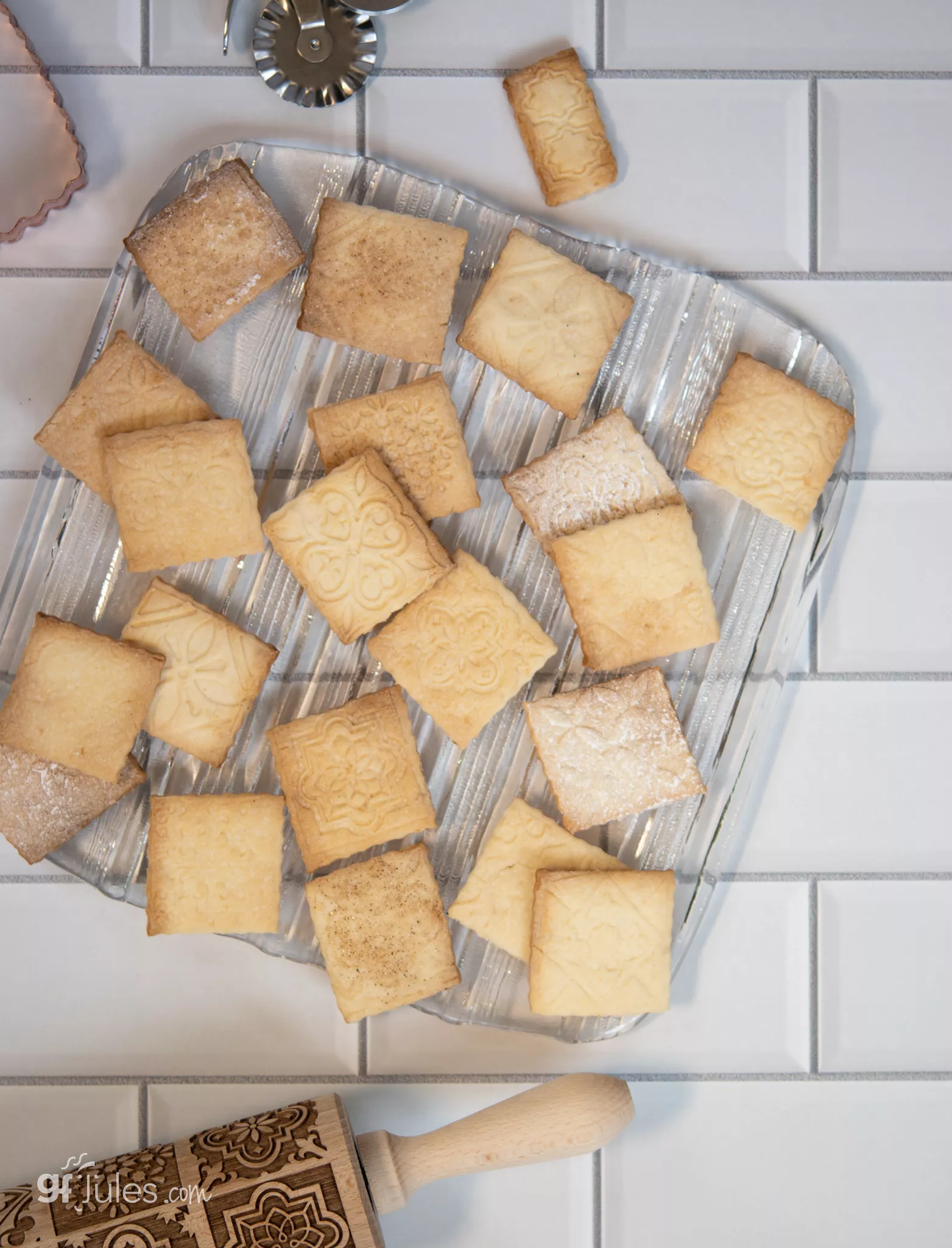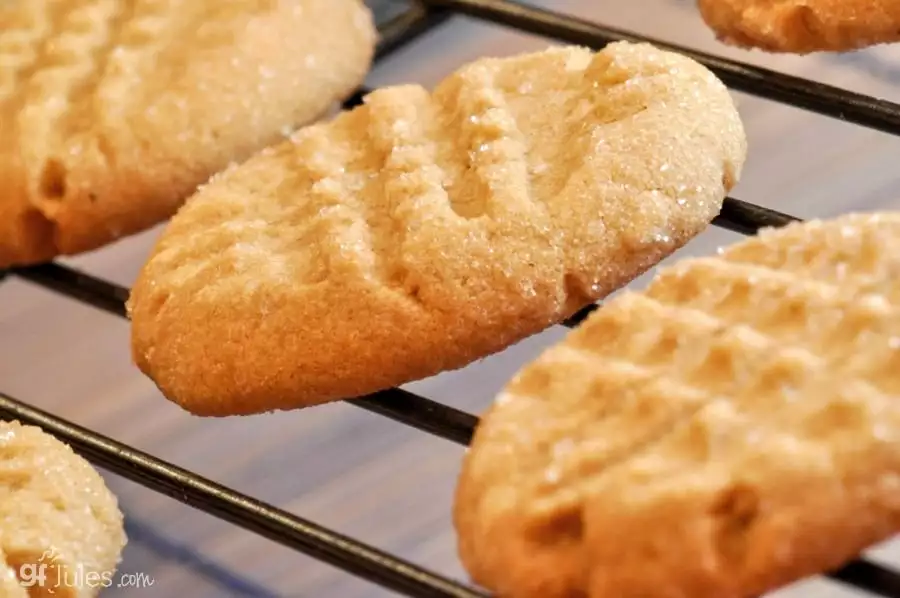If you’re here looking for gluten free cookie baking help, you’re not alone. Many people have trouble with their gluten free cookies — too thin, spread too much, too crispy, too cakey, too crumbly, too dry, overbaked … there are so many ways gluten free cookies can go wrong. But the good news is that there are so many ways to fix these problems! I have 17 gluten free cookie baking tips for you to bake yourself to cookie nirvana.
And no worries if your gluten free cookies must also be dairy-free … did you know that all the recipes on my site are both gluten free and dairy free?
But what if they must be egg-free, too? Would it surprise you to learn that using Ener-G® Egg Replacer instead of eggs actually helps keep most gluten-free cookie recipes from spreading?!) For more egg substitutes and tips, hop to my vegan egg substitutes article!
While most people tend to get a bit frustrated with their “free from” cookie baking results, if you keep these 17 tips handy next time you’re baking cookies, you’ll be baking your way to soft, chewy gluten free cookie success!

17 Gluten Free Cookie Baking Tips
1- Make sure your ingredients are the right temperature.
Follow the recipe directions for ingredient temperatures, and if none are noted, use this rule of thumb for all recipes, not just cookies: ROOM TEMPERATURE INGREDIENTS. This does not mean soft butter and it doesn’t mean cold eggs. It means everything should be as if you left it on the counter for an hour or two, ~70 F/20 C.
For cookies though, you have a choice when it comes to butter temperature.
- Room Temperature Butter = soft, fluffy cookies
- Soft Butter = soft cookies, cookie spread
- Melted or Browned Butter = chewy, flat cookies with crispy edges
- Cold Butter = thicker, crispier cookies
2- Cream the room temperature butter or shortening with the sugar with an electric mixer before doing anything else.
This step will help whip up the butter or shortening and make it fluffier by incorporating air into the batter, while also breaking down the sugar a bit, so that it doesn’t melt as much (e.g. spread) when baking. Unless you like your cookies very crispy and flat, don’t melt the butter, just use room temperature butter (around 70 F) — it should still be firm, but not cold.
3- Bake with a combination of fats.
Butter (or non-dairy butter alternative – i.e. Earth Balance® Buttery Sticks — NOT spreads because they … spread! — see my dairy-free butter recommendations here) and shortening or oil, rather than just butter alone works well to hold gluten free cookies together, giving more body to the dough to prevent spreading. {To see more on the benefits of this combination, see my video!}
The shortening I recommend is Spectrum Palm Oil Shortening — it’s organic, Fair Trade Certified and Sustainable Palm Oil Certified. It’s also non-hydrogenated. It works well when you’re experiencing cookie spread.
4- Always cover cookie sheets with parchment paper unless the recipe directs otherwise.
It promotes even baking, prevents cookies from sticking to the sheet (and then breaking apart when removed), doesn’t leave a greasy aftertaste on the bottoms of the cookies, and helps you spend less time in the kitchen doing clean-up duty when you’re done – BONUS!
5- Chill your dough well before baking.
(Particularly when dealing with rolled cookie doughs) A lot of gluten free bakers will tell you to chill doughs to minimize grit — this isn’t necessary with gfJules Flour because there is NO GRIT! But it’s a good idea in warm kitchens, if you’re working with browned or warmed butter, or if you’re rolling the dough. It reduces stickiness of gluten free doughs and also can enhance the flavor, but again, it’s not necessary with gfJules Flour or Cookie Mixes. If you find your cookies are too crispy for your liking, do not chill the dough before baking.

6- How to I get my cookies to be less thin?
If your cookies are too thin and crispy, use soft butter, do not chill the dough, bake less time and consider raising the temperature of your oven by 25 degrees. You can also substitute brown sugar for granulated sugar (or some proportion thereof) to help bring more softness and chew to your cookies. If you can tolerate eggs, try adding an egg yolk to your cookie dough for even chewier cookies.
7- How do I fix crumbly gluten free cookie dough?
If your cookie dough is too dry and crumbly, just add back to the mixing bowl and stir in a couple tablespoons of your favorite milk or an egg. Add more if needed – the dough needs to hold together, but most cookie doughs shouldn’t be sticky. Sometimes I’ll keep cookie dough in my fridge or freezer and when I go to bake some, the dough has dried out from the cold. Same solution: bring to room temperature then mix in a few tablespoons of milk. Voila – cookie dough like new!

8- Bake by weight.
Bake by weight, as opposed to volume (using cups), is always more accurate. One measured cup of my gfJules All Purpose Gluten-Free Flour should weigh 135 grams. If using my gfJules Multigrain Biscuit and Breakfast Baking Flour (corn-free), 1 cup weighs 140 grams. If using my grain-free Nada Flour, 1 cup weighs 110 grams.
Measuring your ingredients inaccurately can throw any recipe off, especially finicky cookie recipes! Read more about how to accurately measure your gluten free flour in this post, and grab a kitchen scale here — you won’t regret it!

9- Don’t put too many additions into any cookie recipe.
For example, with chocolate chip cookies, adding too many chocolate chips will cause the cookies to spread, as there is not enough dough to bake up for support. This is one reason why I like using Enjoy Life® MINI chips (and they’re dairy, soy & nut-free, too!).
10- Add extra gluten free flour.
If your cookies still insist on spreading, add an extra 1/4 cup of my gfJules Gluten Free All Purpose Flour to the remaining dough to help hold them together (also helps at high altitude!).
11- Make sure your baking soda and/or baking powder are fresh.
These are the leavening agents in your cookie recipe and if they are no longer active, your cookies won’t puff up and may spread more. Try a fresh container if they’ve been open longer than 3 months.

12- Let your cookies cool before removing them from the parchment.
I slide the parchment onto wire cooling racks after 5 minutes or so, and let them fully cool before I remove them. Allowing them time to set after baking prevents them from falling apart during transfer. Once they’re cooled, they are no longer fragile … but still chewy and delicious!
13- Use convection settings.
If your oven has the option, try baking using convection settings, rather than static temperature. If you have a convection setting on your oven and a convection temperature is not given, simply reduce the static temperature by 25 degrees when using your convection setting and bake for a bit less time. Watch closely so you don’t over-bake!

14- Reduce oven temperature.
In fact, go ahead and reduce the temperature on your oven by 25 degrees anyway. If your oven is baking too hot (shockingly, most ovens don’t cook at the accurate temperature!), your cookies will definitely spread! The sugar in the dough may even sneak out the sides of the cookie and form a lacy texture. If this is happening, try baking the next batch at a lower temperature and see what works best with your oven. Also rotate your baking sheet halfway through the bake cycle to promote even baking.
15- Take your cookies out BEFORE they look done.
With chocolate chip cookies, for example, I remove them when the centers still look a bit doughy. As they cool, they are still cooking. Taking them out of the oven at this point will ensure that they stay chewy!

16- Use a tried and true gluten free cookie mix.
It’s faster and easier than weighing out and adding other ingredients, and you’ll know that it works! Try my delectable and uber-versatile, award-winning gfJules Cookie Mix and my easy gfJules Sugar Cut Out Cookie Mix!
And don’t forget homemade gluten free graham crackers with my gluten free Graham Cracker/Gingerbread Mix!

17- How do I store gluten free cookies?
You have two options: freeze gluten free cookie dough or freeze baked gluten free cookies. *Note, for cookies made with gfJules Flour or Mixes, they stay fresh for up to a week if stored in an air-tight container on the counter after baking.
To freeze gluten free cookie dough, place cookie dough balls on a parchment-lined baking sheet that will fit in your freezer. Freeze until cold, then transfer to a freezer bag and return to the freezer. To bake, just follow the cookie recipe directions but lower the oven temperature by 15 degrees and bake about 2 minutes longer.
To freeze baked gluten free cookies, either place on a parchment-lined baking sheet that will fit in your freezer and freeze until cold then transfer to a freezer bag or simply place in a freezer bag and store in the freezer for up to 3 months.

♦Want the gluten free recipes for my Vanilla Wafers, Oatmeal Cookies, Hamantaschen, Spritz, Snowball Cookies, Chocolate Crinkle Cookies, Sugar Cookies, Peanut Butter Cookies, Red Velvet, and Lemon Shortbread, among others? Search my RECIPES tab or the search bar at the top of every page and you’ll find over 60 gluten free cookie recipes for the taking!♦
And don’t forget to sign up for all things Gluten-Free Cookie by joining the Gluten-Free Cookie Swap – your community cookie recipe share site on Facebook!













 (4 votes, average: 3.75 out of 5)
(4 votes, average: 3.75 out of 5)
















Wow, thanks for your post today. Cookies are also my downfall. Seem to have the most problem with them. I will try some of your suggestions.
Fantastic baking tips! I need to remember to try chilling my cookie dough even when it is not just for roll out cookies
Thanks for today’s post I too love the Enjoy Life chips, my hubby & I love chocolate chip cookies using these chips!
I too love the Enjoy Life chips, my hubby & I love chocolate chip cookies using these chips!
I’ve just started gluten-free cooking. I have not tried cookies yet. We are also dairy free and oil free so I’m a little intimidated to try.
Holly – you’ll be just fine! Check our GlutenFreeCookieSwap on Facebook for more recipes too, and post questions anytime for help! We have a remarkably helpful community!
Thanks so much for the tips- especially about sliding the paper onto the rack to finish cooling!
I am a teacher, and I promised my students cookies for beating me in a game- and I promised to make something we could ALL share (I’m the celiac, and they are very curious). Then, I found out one student is egg free- and I knew exactly where to turn! I’m making your oatmeal raisin cookies over the memorial day break- I’ll let you know what my students think!
Casandra – that’s fantastic! Spreading gluten-free awareness, one student at a time!
I shared on facebook
I haven’t tried baking any cookies yet, but I will definitely keep your tips handy!
Lots of great tips for baking cookies.
I’ll have to try out the butter and shortening combo…my cookies sometimes have a mind of their own.
Glad to hear abt using egg replacer instead of real eggs.
Thanks for all the great tips. i look forward to my next batch of cookies.
YUMMY thanks
This is so useful! Thanks for posting a wonderful list of tips, we can now make gluten free cookies with ease!
Thanks for #4, 7, and 9. They are very helpful to me! Shared on facebook!
Thanx for the tips–and the reminder of how much a cup of your flour weighs! I had forgotten, but didn’t want to bug you again about it…
Awesome tips that are a must in GF cookie baking!!
shared on FB and twitter
https://twitter.com/#!/denimorse/status/202048393705566208
Thanks for this! I’ve been having a lot of trouble with my cookies basically disintegrating lately.
Thank you for all the ideas with cookies. Very helpful!
Great ideas and tips for baking cookies. Can’t wait to try them.